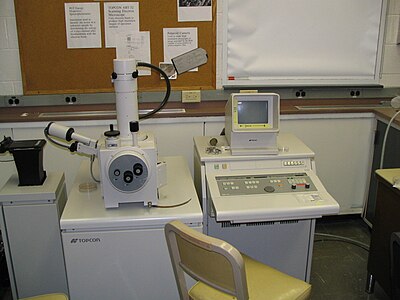Analytical Forensic Pharmacology/Microscopic Observation
The visual analysis of unknown substances including drugs may be further analyzed by microscopy. The microscope has gone hand in hand with forensics ever since the time of the fictional Sherlock Holmes. Today the microscope made familiar by Sherlock Holmes takes many different forms and they may be optical or electromagnetic.
Compound Optical Microscope
[edit | edit source]The most common form of the microscope is still the optical compound type that mostly everyone is familiar with.
Forensic scientists still use optical compound microscopes for analysis of substances, yet other technologies exist as well, – electron microscope (scanning and/or tunneling), phase contrast, and microscopes with polarimeter filters which can be utilized to observe certain frequencies of light.
One of the simplest uses of visual observation for the detection of materials of forensic interest is in the analysis of the marijuana leaf. Marijuana leaves exhibit bear claw shapes called cystolithic hairs on the dorsal leaf surface.(Bell 304)(Figure-2) This visual observation is specific enough to narrow down the genera of the marijuana plant, but not specific enough to tell whether or not it is Cannibus sativa with a high level of the active ingredient Δ9-THC.
Fluorescent Microscopy
[edit | edit source]Fluorescent microscopy is most commonly used in a series of assays known as immunocytochemistry which will be discussed later on page 21. However, Fluorescent Microscopy is also useful in the identification of LSD. LSD when isolated can be detected in 1ppm by fluorescence. Using filters specific for certain wavelengths, forensic scientist can look for light at the 400 nm wavelength which is indicative of LSD presence. (Fanga et al, 2002)
Scanning Electron Microscopy
[edit | edit source]Scanning electron microscopy (SEM) can be used to obtain the same results found with phase contrast microscopes. However it is more often used in the presumptive analyses associated with the identification of unique crystal structures. SEM is often paired with other technologies such as x-ray crystallography sources. The most modern techniques of this type work use the SEM and energy-dispersive X-ray analysis (EDXRA) to allow the microscope analyze components of samples.

